Myles Brager, Max Harrison, and Max Tauber, have all been taxi drivers since the 1930s.
Author Archives: ArchivesBlogs
Se aprueban reformas y adiciones a Ley de Archivos del Estado de Nayarit
Diputados aprueban de ley de archivos con valor histórico
http://www.elsoldenayarit.mx/ 21/10/2015
La reforma da prioridad a la conservación de la documentación en su soporte original, ello para garantizar que se le dé el debido cuidado a aquellos documentos que por la relevancia que representan sean considerados como históricos; asimismo establece como garantes de la conservación a los particulares que cuenten con archivos privados que ostenten valor histórico.
De igual forma, se estipula la obligación de que quien se desempeñe como responsable de los archivos históricos cuente con conocimiento y experiencia en la materia para llevar a cabo de manera eficiente tanto los procesos de descripción, conservación, resguardo o restauración que se requieran, para que el contenido de los documentos y la información se preserven.
Para los integrantes de la Trigésima Primera Legislatura la memoria histórica representa la clave para evaluar el origen, la vida, el desarrollo o evolución de alguna dependencia o entidad, ya que con ello se garantiza su debido funcionamiento y el desarrollo democrático de la sociedad al otorgar certeza de la gestión y el desempeño de la administración pública.
Archivos eliminados recuperados por Policìa de Investigaciòn en Chile
http://www.24horas.cl/ 21/10/2015
El abogado querellante, Mario Zumelzo, informó que tras el trabajo de la policía, “eventualmente se podrían pedir nuevas diligencias y acciones legales”.
La Policía de Investigaciones confirmó que se logró recuperar la totalidad de archivos desde el computador personal de Sebastián Dávalos mientras se desempeñaba como director sociocultural de La Moneda.
De acuerdo a lo publicado por La Tercera, la Brigada de Cibercrimen logró respaldar los documentos que habían sido borrados desde el ordenador cuando se confirmó la renuncia del hijo de la Mandataria a su puesto.
Tras el hecho, el abogado querellante, Mario Zumelzu, manifestó al medio de comunicación que lo que corresponde ahora es la comparación del informe que elaboró el OS-9 de Carabineros con el de la PDI, “y con esto eventualmente pedir nuevas diligencias y acciones legales”.
Mediante el còdigo secreto de las impresoras a color pueden espiar
Cuidado, pueden espiarte a través de las impresoras
http://www.adslzone.net/ 20/10/2015
La impresora se ha convertido en un periférico indispensable para casi cualquier usuario de ordenador. Indispensable en el ámbito profesional y de gran utilidad en el doméstico, este dispositivo es un gran aliado para obtener al instante copias en blanco y negro o a color, de los archivos que tengamos en nuestro ordenador ya sean documentos, imágenes, correos electrónicos o páginas web. Pero ahora también puede convertirse en un peligroso enemigo ya que se ha descubierto el código secreto de las impresoras a color mediante el cual es posible espiar a los usuarios.
Tal y como informan nuestros compañeros de Redes Zone, el espionaje a través de las impresoras a color era algo ya conocido y admitido por el Gobierno de Estados Unidos, una administración que se ha visto envuelta en numerosas polémicas por la vigilancia no autorizada de ciudadanos y corporaciones. Pero ahora ya se conoce el método usado para poder acceder a datos de los usuarios y todo radica en el patrón dejado por los puntos que las impresoras generan en los documentos a la hora de imprimirlos.
El descubrimiento ha sido llevado a cabo por la EFF (la Electronic Frontier Foundation), que ha determinado como los puntos de color amarillo que las impresoras dejan en cada impresión indicarían la hora y la fecha del documento. Estos puntos de un tamaño inferior al milímetro de diámetro se repiten en todas las páginas del documento que se imprime creando un patrón que puede analizarse aunque para ello hay que echar mano de instrumental óptico ya que son imperceptibles a primera vista.
El código secreto de Xerox ha sido el primero en develarse
La EFF ha conseguido descifrar el algoritmo usado por las impresoras de la marca Xerox, pero este método de puntos también es utilizado por todas las marcas de impresoras láser a color como Canon o Brother entre otras. Aunque las propias marcas ya han comunicado que estos códigos secretos solo pueden ser desvelados por las agencias de seguridad de los Gobiernos, esto no quita el foco del problema ya que tal y como desveló Edward Snowden, Estados Unidos ha recurrido al espionaje de los ciudadanos en numerosas ocasiones.
Pásate por nuestro foro de seguridad informática
El objetivo de la EFF es hacer públicos todos los algoritmos del resto de marcas y el caso de Xerox solo ha sido el primero. De ese modo, los usuarios podrán al menos conocer de qué forme se está accediendo a los datos, que en teoría solo se usarían en lo relativo a investigaciones penales falsificadas.
La inseguridad de los correos electrònicos.
http://altadensidad.com/ 20/10/2015
El director de la Agencia Central de Inteligencia (CIA), John Brennan, al parecer tenía su correo electrónico hackeado y expuesto en línea.
Los detalles del presunto hackeo aparecieron en el New York Post, quien tenía contacto directo con el pirata, del que dice que se trata de un estudiante de secundaria no identificado y que “no es musulmán y estuvo motivado por la oposición a la política exterior estadounidense y el apoyo a Palestina”.
Autor: http://www.europapress.es/
Amherst vs Wesleyan Football
 In honor of Homecoming Weekend, and the Amherst vs Wesleyan football game tomorrow, here are a few glimpses of past games, mostly from our Athletics Collection. Here’s hoping the score tomorrow is more like the one in 1915 or 1935, and less like 1899!
In honor of Homecoming Weekend, and the Amherst vs Wesleyan football game tomorrow, here are a few glimpses of past games, mostly from our Athletics Collection. Here’s hoping the score tomorrow is more like the one in 1915 or 1935, and less like 1899!
Amherst vs Wesleyan Football
 In honor of Homecoming Weekend, and the Amherst vs Wesleyan football game tomorrow, here are a few glimpses of past games, mostly from our Athletics Collection. Here’s hoping the score tomorrow is more like the one in 1915 or 1935, and less like 1899!
In honor of Homecoming Weekend, and the Amherst vs Wesleyan football game tomorrow, here are a few glimpses of past games, mostly from our Athletics Collection. Here’s hoping the score tomorrow is more like the one in 1915 or 1935, and less like 1899!
Greensboro community history site added
Material digitized as part of UNCG’s partnership with the Hayes-Taylor YMCA Youth Achievers program is now online!
Over the past year, we have been working with students in the Hayes-Taylor program and with community members to uncover rare and personal items that are of unique historical value and that might not have made their way into a digital collection otherwise. We encouraged community members to contribute items that they thought were significant and documented a particular aspect of Greensboro’s history with specific attention given to African-American communities in the southeastern quadrant of the city.
 Greensboro residents brought in some amazing items. Here is a small sample:
Greensboro residents brought in some amazing items. Here is a small sample:
- Two photos documenting Greensboro’s East Market Street business district, which was destroyed in a 1960s urban renewal project.
- A scrapbook created by Mrs. Hyla Cundiff druing her time at Johnson C. Smith University in Charlotte from 1944-1948.
- Material documenting the life and work of Walter Lewis McNair, the first African-American pharmacist in Greensboro.
- A photo album containing rare photographs of Dudley High School in the late 1930s taken by a student who later became a Tuskeegee Airman.
- Several photographs showing the Caldwella nd Foushee families and their lives in Greensboro’s Terra Cotta community from the 1950s to the 2000s.
Friends of the Vancouver Archives Photographic Cold Storage Facility
We have a specialized, custom-built freezer to provide the highest standard of care for the storage of our photographic materials. It was the first institutional freezer built to the specifications researched by the Smithsonian Institution and it was officially opened by Mayor Philip Owen on February 20, 2002.
Why a Freezer?
Some types of photographic materials are unstable and cold storage will prolong their useful lives. Storage at freezer temperatures will prolong their lives the longest.
Without cold storage, cellulose acetate negatives wrinkle and become brittle
as they give off acetic acid (vinegar).
Colour photographs will fade, even when stored in the dark. Frozen storage will stop the colours from fading further.
Movie films can have the same problems and will also benefit from frozen storage.
How big was our problem?
In 1995 and again in 1998, we surveyed our deteriorating acetate negatives using A-D (Acid-Detecting) Strips. These strips change colour to indicate how deteriorated the acetate negatives are, giving us a good idea how much time they have left before they become wrinkled. They were developed by the Image Permanence Institute for the motion picture industry and won an Academy Award in 1997.
We noticed that the negatives had deteriorated in the three years between tests and we counted about 113,000 negatives that should be frozen as soon as possible, with hundreds of thousands more that needed freezing eventually.
We packaged the high priority negatives in Critical Moisture Indicator packaging developed by the conservation research labs at the Smithsonian Institution and adapted by Betty Walsh of the British Columbia Archives. The packaging kept the moisture content of the negatives low by using two thick, sealed plastic bags, and pieces of dried mat board. The moisture content could be monitored using the small blue indicator square on one end.
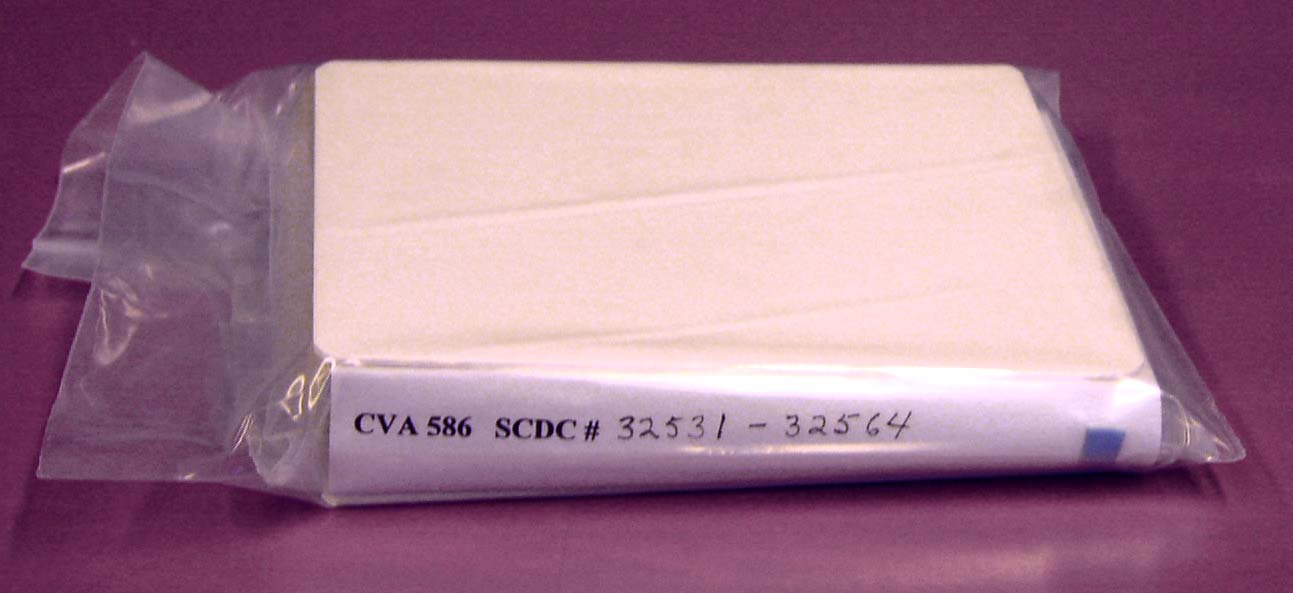
Critical Moisture Indicator package: 2 layers of ziploc bags, absorbent mat board, identification, and a blue square to indicate the moisture content.
The packages were created, assembly-line style, in a ventilated area to protect staff from the acetic acid given off by the negatives.
In 2000, the packages were boxed and driven to a cold storage facility in Port Kells which specialized in storing frozen food. They were secured on a pallet and stored on a high shelf in a quiet corner.
An hour down the highway, under layers of pallet wrap, corrugated plastic and packaging, access was difficult, but the negatives were safe.
OUR OWN FREEZER
We began to plan for our own on-site facility. The Smithsonian was sponsoring research into a low-cost and energy-efficient freezer that archives could use, and we discussed the design with them while the research was underway. Once it looked like the design worked, we built one.
The Friends of the Vancouver City Archives raised funds to purchase the freezer. The freezer was built from an ordinary, modular walk-in freezer, as used by restaurants but with a couple of small changes to help keep the humidity low. It was built in 2001. After testing in early 2002, we brought our negatives back from Port Kells and put the boxed packages on shelves in the freezer in time for the opening in February 2002.
MORE EFFICIENT STORAGE
The Critical Moisture Indicator packaging was meant for small numbers (perhaps fewer than 20,000) of photographs, as a professional photographer might have. It’s not very efficient for larger volumes, as it involves freezing many layers of packaging—bags and mat board—which take up a lot of room in the expensive freezer space. We knew this, but we had to act quickly and there was no other reliable way of packaging them at the time.
Fortunately, the Smithsonian was also researching a storage method that could store photographic negatives safely and with minimal packaging. Storage cabinets with gasketted doors were put into the freezer. The shelves were lined with mat board and half a kilogram of dried silica gel was placed in each cabinet. The photographs could be stored on the shelves in their regular archival boxes, without extra plastic bags. We were able to get 50,000 negatives into the first cabinet we filled.
Traditionally, cold storage for cultural materials uses active dehumidification systems, which means they not only have an electrical system that controls temperature, but a separated electrical system that removes humidity from the cold air. Active dehumidification systems are
- expensive to purchase and install (especially at temperatures below zero)
- fussy to maintain (requiring HVAC engineers to adjust)
- require about four times the electricity to achieve the same humidity at freezer temperatures
The passive dehumidification system we use, which combines the freezer design with the gasketted cabinets, is
- inexpensive to purchase (some mat board and silica gel)
- easy to maintain (regular maintenance calls and the easy task of drying of the silica gel)
- green in its energy consumption

Two of the four rows of cabinets in the freezer today. The camping coolers are used to gently acclimatize the photographic materials to a change in environment when they are moved in or out of the freezer.
Today, the freezer holds approximately 750,000 negatives, colour slides and films. We still receive inquiries from around the world on our experience with this successful project.
Download a detailed, illustrated account of our work to provide cold storage for photographs at the Canadian Council of Archives web site.
By the Numbers: Connecting with Customers in Person and Online
At the National Archives, we connect with customers in a multitude of ways: face-to-face, over the phone, across the desk, in our research rooms, in the classroom and of course, online. We serve a diverse set of customer communities, including educators, historians, genealogists, researchers, veterans and now groups such as civic hackers, Wikipedians and many more. To meet our goal of making access happen, we need to become more agile, more creative in connecting with them – whoever they are, wherever they are, to deliver what they want when they want it.
This second post in a series for American Archives Month explores the impact the National Archives is making as we strive to meet the needs and requests of our researchers, visitors, and customers, both in person and online.
As we review the numbers from the past year, we see that our researcher community is as active as ever before and the total number of researchers we serve is growing. Researchers explore our nation’s history through documents, photos, and other records in the holdings of the National Archives. During Fiscal Year 2015, the National Archives opened its doors to 84,000 researchers nationwide who visited our research facilities (a slight decrease from 104,000 in FY 2014). In terms of written reference requests (requests received through fax, letter or email), our staff across the country answered over 1.1M requests in fiscal year 2015, which is a 5% increase over last year. Our online research catalog received over 1 million views in fiscal year 2015, which is an increase of 20% from the previous year (834K). Additionally, there were over 243 million views of National Archives records on our partner websites, including Ancestry.com, Fold3 and FamilySearch. As the number of platforms we use to connect with our customers grows, so does the total number of researchers we are able to help.
Another important consideration is how information seekers are benefiting from and interacting with National Archives records online. On Wikipedia, for example, more than 7,600 National Archives images are currently being used in Wikipedia articles, and those articles have been viewed 925 million times during Fiscal Year 2015. These incredible numbers demonstrate how much online researchers, as well as Wikipedia editors, interact with our records on a daily basis.
The outstanding work NARA staff perform on a daily basis to engage with the public makes all the difference in satisfying the needs and requests of our researchers, whether in person or online. Through their many efforts and dedication to our mission, our staff will continue to honor our goal to connect with customers, understand their unique needs, and respond to their requests with professionalism and courtesy.
See my first post in this series exploring the impact the National Archives is making through our increased efforts to make access happen by maximizing value through web and social media. Stay tuned for more details on the results of our digitization and citizen engagement efforts.
![]()
The Song that Made Janis Ian the Most Notorious Folk Singer in America
It’s hard to imagine a teenage singer-songwriter today climbing the Billboard charts with a folk-rock song about a young, interracial love affair. But that’s exactly what happened in 1966 when Janis Ian, a 16-year-old from East Orange, New Jersey, released “Society’s Child (Baby I’ve Been Thinking).”
This live studio recording aired on WNYC only months before Ian became a household name and “Society’s Child” became a flash point in the 1960s culture wars. The song was banned at radio stations across the country, but despite – or maybe because of – the controversy, it reached #1 in several major radio markets, and peaked at #14 on the Billboard Hot 100.
This performance includes five songs, four of which appear on the 1966 full-length album also called “Society’s Child”. The fifth song we’ve been unable to identify on any of Ian’s released material. Ian calls it a “bleep bleep” song, presumably for its racy lyrics, which detail the exploitation and fears of a teenage girl on the streets of New York City.
1. Younger Generation Blues2. Society’s Child3. I’ll Give You A Stone If You’ll Throw It (Changing Thymes)4. (Too Old To) Go ‘Way Little Girl5. Bleep Bleep Song
Audio courtesy of the Dave Sear Folk Music Collection.
The Days of Our Lives: FSU Archives Edition
What do archivists do all day, anyway? Look at old photos? Dust yearbooks? Take papers from one file folder and put them in another?
Those are all true to some extent, but university archivists play more roles in their community than one might think. Take a look at some of the extraordinary events during an average week in FSU Special Collections and Archives:
Thursday, October 15:
Students from the ART5928 workshop “Creating Experiences” visit the Claude Pepper Museum. Their project this semester involves creating a public event that could be held in in a museum space. The students have designed a Claude Pepper Pajama Party event and social media campaign, and today they’re walking through their ideas with Pepper Library Manager Rob Rubero.

FSU Special Collections has always considered local history one of its collecting strengths. In an effort to deepen community connections and learn more about the Tallahassee music industry, Rory Grennan and Katie McCormick attend a public appearance by influential songwriter and producer George Clinton. Aside from smiles and photo opportunities, our archivists enjoy many conversations with Clinton’s family and associates about his work and his legacy.

Friday, October 16:
Today, the Special Collections Research Center reading room has the privilege of hosting the members of the Florida State University History Club. A dozen history undergraduates attend an informational presentation by Manuscript Archivist Rory Grennan and Rare Books Librarian Kat Hoarn. Presentations and instructional sessions for students, faculty, and the public are a core part of the Special Collections mission, and occur frequently at the beginning of the school year. History Club members are excited to see 4000 years of human history laid out in documents from our collections including cuneiform tablets, a page from a Bible printed by Gutenberg, and artist books from the 21st century.

Monday, October 19:
Monday morning, archivists Sandra Varry and Krystal Thomas visit the University Registrar’s office to consult on the preservation of student transcripts on microfilm. The filmed student records see heavy use, and unfortunately enough of the film has been worn down that some records are losing information. The group discusses modern strategies such as digitization to preserve these essential historical records that document a century of higher education.
Later, Sandra Varry and division staff prepare for a new exhibit opening today in the Special Collections Exhibit Room on the first floor of Strozier Library. “Mittan: A Retrospective” celebrates the work of photographer Barry Mittan, and documents student life at FSU in the 1960s and 1970s. The exhibit was curated by graduate assistant Britt Boler and runs through January 2016.

In the afternoon, Krystal Thomas carefully reviews and uploads recently-digitized cookbooks and herbals to the FSU Digital Library. The Digital Library features digitized versions of the highlights of our collections, as chosen by Special Collections staff and our users, and new content is added regularly by archives staff.
Tuesday, October 20:
Things They Don’t Teach You In Grad School #47: Water and vinegar makes an effective, non-abrasive cleaner for a headstone.
Former FSU faculty member Paul Dirac was a giant in the fields of mathematics and quantum mechanics, and his papers are a frequently-consulted resource by researchers at FSU Libraries. Since no members of the Dirac family remain in Tallahassee, it has become the unofficial duty of our library and archives staff to visit Dirac’s grave once a year and see that it is kept clean. October 20th is the anniversary of Dirac’s death, and seems an appropriate time to visit the site. Archivists Katie McCormick, Rory Grennan, and Krystal Thomas, accompanied by library Director of Development Susan Contente and a handful of Physics Department students, scrub the headstone and plant fresh flowers this afternoon.

After: A clean headstone with fresh flowers planted on either side.
Wednesday, October 21:
Early this morning, archives staff notice an uncharacteristic rise in temperature in the stacks. After confirming initial impressions with a few temperature readings, contact is quickly made with library facilities staff to take steps to correct an issue with the building’s HVAC systems. Constant environmental monitoring is an important part of preserving our collections, as paper, film, and other substrates are vulnerable to fluctuations in temperature and humidity. There’s no point to collecting items that can’t be made to last! You never know what someone might need next week…
The Days of Our Lives: FSU Archives Edition
What do archivists do all day, anyway? Look at old photos? Dust yearbooks? Take papers from one file folder and put them in another?
Those are all true to some extent, but university archivists play more roles in their community than one might think. Take a look at some of the extraordinary events during an average week in FSU Special Collections and Archives:
Thursday, October 15:
Students from the ART5928 workshop “Creating Experiences” visit the Claude Pepper Museum. Their project this semester involves creating a public event that could be held in in a museum space. The students have designed a Claude Pepper Pajama Party event and social media campaign, and today they’re walking through their ideas with Pepper Library Manager Rob Rubero.

FSU Special Collections has always considered local history one of its collecting strengths. In an effort to deepen community connections and learn more about the Tallahassee music industry, Rory Grennan and Katie McCormick attend a public appearance by influential songwriter and producer George Clinton. Aside from smiles and photo opportunities, our archivists enjoy many conversations with Clinton’s family and associates about his work and his legacy.

Friday, October 16:
Today, the Special Collections Research Center reading room has the privilege of hosting the members of the Florida State University History Club. A dozen history undergraduates attend an informational presentation by Manuscript Archivist Rory Grennan and Rare Books Librarian Kat Hoarn. Presentations and instructional sessions for students, faculty, and the public are a core part of the Special Collections mission, and occur frequently at the beginning of the school year. History Club members are excited to see 4000 years of human history laid out in documents from our collections including cuneiform tablets, a page from a Bible printed by Gutenberg, and artist books from the 21st century.

Monday, October 19:
Monday morning, archivists Sandra Varry and Krystal Thomas visit the University Registrar’s office to consult on the preservation of student transcripts on microfilm. The filmed student records see heavy use, and unfortunately enough of the film has been worn down that some records are losing information. The group discusses modern strategies such as digitization to preserve these essential historical records that document a century of higher education.
Later, Sandra Varry and division staff prepare for a new exhibit opening today in the Special Collections Exhibit Room on the first floor of Strozier Library. “Mittan: A Retrospective” celebrates the work of photographer Barry Mittan, and documents student life at FSU in the 1960s and 1970s. The exhibit was curated by graduate assistant Britt Boler and runs through January 2016.

In the afternoon, Krystal Thomas carefully reviews and uploads recently-digitized cookbooks and herbals to the FSU Digital Library. The Digital Library features digitized versions of the highlights of our collections, as chosen by Special Collections staff and our users, and new content is added regularly by archives staff.
Tuesday, October 20:
Things They Don’t Teach You In Grad School #47: Water and vinegar makes an effective, non-abrasive cleaner for a headstone.
Former FSU faculty member Paul Dirac was a giant in the fields of mathematics and quantum mechanics, and his papers are a frequently-consulted resource by researchers at FSU Libraries. Since no members of the Dirac family remain in Tallahassee, it has become the unofficial duty of our library and archives staff to visit Dirac’s grave once a year and see that it is kept clean. October 20th is the anniversary of Dirac’s death, and seems an appropriate time to visit the site. Archivists Katie McCormick, Rory Grennan, and Krystal Thomas, accompanied by library Director of Development Susan Contente and a handful of Physics Department students, scrub the headstone and plant fresh flowers this afternoon.

After: A clean headstone with fresh flowers planted on either side.
Wednesday, October 21:
Early this morning, archives staff notice an uncharacteristic rise in temperature in the stacks. After confirming initial impressions with a few temperature readings, contact is quickly made with library facilities staff to take steps to correct an issue with the building’s HVAC systems. Constant environmental monitoring is an important part of preserving our collections, as paper, film, and other substrates are vulnerable to fluctuations in temperature and humidity. There’s no point to collecting items that can’t be made to last! You never know what someone might need next week…
Rest in Peace Professor
Yesterday was the 31st anniversary of Paul Dirac’s death. As has become tradition, faculty and staff from the FSU Libraries, where we hold the physicist’s papers, and students from the Physics departments visit Dirac’s grave to clean it and plant flowers. Learn more about this in a post later this week but for now, we honor Professor Dirac.

Rest in Peace Professor
Yesterday was the 31st anniversary of Paul Dirac’s death. As has become tradition, faculty and staff from the FSU Libraries, where we hold the physicist’s papers, and students from the Physics departments visit Dirac’s grave to clean it and plant flowers. Learn more about this in a post later this week but for now, we honor Professor Dirac.

A Haunted Halloween
Acting Black: Exhibition, Opening, and Press
Our newest exhibition, “Acting Black: Black Performing Arts in RI since the 1700s”, guest curated by Robb Dimmick, explores the roles played by Black musicians, actors and actresses, models, writers, storytellers, poets, and dancers.
This past weekend the Providence Journal published an article about the exhibit, including a series of beautiful photos.
An opening reception will be held at the library tonight, October 19th, 2015, from 5 – 6:30 p.m. Please join us if you are in the area!
October is LGBT History Month
October is LGBT History Month which gives us all the opportunity to learn more about the LGBTQ+ community and its history around the Tallahassee and right here at Florida State University. LGBT History Month began in 1994 when Rodney Wilson, a Missouri high school teacher who believed that a month should be dedicated to teaching the history of the gay and lesbian community. He organized teachers and community leaders where they picked the month of October because public schools were in session and existing traditions (such as National Coming Out Day on October 11th) already occurred during October.
Gay & Lesbian History Month was recognized and endorsed by a number of national organizations including: GLAAD, Human Rights Campaign, National Education Association and others. By 2006 the Equality Forum took over the responsibility for providing content, promotion, and resources for LGBT History Month.
FSU Special Collections is currently processing the records of FSU’s Pride Student Union. The collection is part of FSU Special Collections Heritage Protocol & University Archives. This collection shows the rich history of members of the LGBTQ+ community in Tallahassee and at FSU fighting for their civil rights as members of this community and as students fighting to be recognized as a student organization by the Student Government Association.
This year has been an effective year for positive change though there’s still so much more work and education that needs to be done. So far 2015 has brought increased awareness to transgender visibility (though #KeishaJenkins has become the 18th transgender woman of color killed in the United States this year). The Supreme Court ruled in favor of legalizing nationwide marriage equality earlier this year. For the second time ever (EVER!) the White House held a briefing on challenges facing bisexual people.
Research shows that incorporating LGBT history into our curriculum and conversations contributes to a safer environment for LGBTQ+ students.
There are a number of events you can attend this month right here at FSU to show your support!
Now go learn some history!
October is LGBT History Month
October is LGBT History Month which gives us all the opportunity to learn more about the LGBTQ+ community and its history around the Tallahassee and right here at Florida State University. LGBT History Month began in 1994 when Rodney Wilson, a Missouri high school teacher who believed that a month should be dedicated to teaching the history of the gay and lesbian community. He organized teachers and community leaders where they picked the month of October because public schools were in session and existing traditions (such as National Coming Out Day on October 11th) already occurred during October.
Gay & Lesbian History Month was recognized and endorsed by a number of national organizations including: GLAAD, Human Rights Campaign, National Education Association and others. By 2006 the Equality Forum took over the responsibility for providing content, promotion, and resources for LGBT History Month.
FSU Special Collections is currently processing the records of FSU’s Pride Student Union. The collection is part of FSU Special Collections Heritage Protocol & University Archives. This collection shows the rich history of members of the LGBTQ+ community in Tallahassee and at FSU fighting for their civil rights as members of this community and as students fighting to be recognized as a student organization by the Student Government Association.
This year has been an effective year for positive change though there’s still so much more work and education that needs to be done. So far 2015 has brought increased awareness to transgender visibility (though #KeishaJenkins has become the 18th transgender woman of color killed in the United States this year). The Supreme Court ruled in favor of legalizing nationwide marriage equality earlier this year. For the second time ever (EVER!) the White House held a briefing on challenges facing bisexual people.
Research shows that incorporating LGBT history into our curriculum and conversations contributes to a safer environment for LGBTQ+ students.
There are a number of events you can attend this month right here at FSU to show your support!
Now go learn some history!
Cartas y fotos de los famosos valen millones de dolares
http://www.sipse.com/ 09/10/2015
Los artículos fueron subastados este sábado en 28 mil 400 dólares por la casa Modern Auctions.
MIAMI, EU.- Un par de decenas de correspondencia personal de Jacqueline Kennedy Onassis y fotografías de la exprimera dama en Palm Beach fueron subastadas por 28 mil 400 dólares.
Los objetos ofertados el sábado en la casa de subastas de Florida Palm Beach Modern Auctions incluyeron cartas escritas a mano de Onassis a su diseñador de interiores, Richard Keith Langham, y a Bill Hamilton, entonces director de diseño de Carolina Herrera.
Onassis intercambió cartas con ambos sobre ropa y muebles que adquiría entre mediados de la década de 1980 hasta su muerte en 1994.
Las cartas escritas por Onassis rara vez son ofrecidas y la casa de subastas generó “un interés tremendo” en los 20 lotes disponibles, de acuerdo con uno de los copropietarios, Wade Terwilliger.
“Cuando uno lleva a cabo una subasta de arte y muebles, no ve a la gente dialogando antes de la misma. Esto fue distinto. La gente quería comentar sobre su ropa y recordar dónde estaban o qué hacían cuando Jackie aparecía con algún atuendo en particular”, comentó.
Los compradores potenciales se relacionaban con la forma de pensar de Jacqueline en cuestión de estilo personal, que incluía instrucciones detalladas de cómo quería sus sacos o cómo le ajustaban sus pantalones y peticiones por más color en su guardarropa, señaló Terwilliger.
El objeto que atrajo la mayor oferta fue un libro de Jacqueline sobre la restauración de la Casa Blanca, que le firmó a Langham. Fue vendido por cuatro mil 575 dólares.
Los archivos secretos de la CIA un tesoro en informaciòn
Ex jefe de la CIA ocultó información sobre el asesinato de Kennedy
http://www.sipse.com/ 09/10/2015
Un informe reveló datos sobre la actividad del asesino y hasta los planes para matar a Fidel Castro.
WASHINGTON, DC.- Aunque prometió cooperar con la investigación del asesinato de John F. Kennedy, el entonces jefe de la CIA, John McCone, ocultó todo tipo de información: desde datos sobre la actividad del asesino, hasta los planes para matar a Fidel Castro. Un informe oficial revela este misterioso entramado.
Un informe publicado en 2013 reveló el trato inapropiado que tuvo la Agencia Central de Inteligencia (CIA) con la Comisión Warren, encargada de investigar el magnicidio. McCone continuó al frente del organismo y fue el encargado de las omisiones, entre ellas, que la CIA no tenía evidencias que sugirieran que el homicida, Lee Harvey Oswald, fuese parte de una conspiración local o extranjera, según ha publicado el portal Politico Magazine.
“Según consta, McCone ocultó de la comisión la existencia de complots de la CIA para asesinar al líder cubano Fidel Castro”, ha informado a su vez ‘The Independent’. El informe está actualmente disponible en el sitio web del Archivo de Seguridad Nacional de la Universidad de George Washington.
El informe del historiador de la agencia David Robarge ubicó a McCone en el corazón de un “encubrimiento benigno”, que tenía la intención de ubicar el trabajo de la Comisión Warren en lo que la CIA creía que era la “mejor verdad”, es decir, que Oswald había actuado por su cuenta. Por lo tanto, al ocultar los planes para matar a Castro, la comisión nunca podría investigar si Oswald tenía cómplices en Cuba o en otra parte del mundo que quisieran matar a Kennedy en represalia por los planes contra el líder de la revolución cubana, según publica el sitio web actualidad.rt.com.
En consecuencia, el informe de Robarge asegura que el exdirector de la central de inteligencia trabajó para aportar una asistencia “pasiva y selectiva” a los investigadores del crimen del presidente.
¿Cuáles fueron los motivos para actuar de esta manera? No están claros. Sin embargo, se sugiere que la misma Casa Blanca fue la que lo instó a ocultar información, con lo que no se revelarían las operaciones encubiertas en Cuba.
Esto no es todo, el informe de 2013 reveló otro dato importante que McCone nunca brindó a la comisión: los contactos que supuestamente mantuvo la agencia con Oswald antes de 1963 y el control de su correspondencia luego de su intento de emigrar a la Unión Soviética en 1959. Incluso, semanas después del magnicidio Oswald se encontró en México con espías cubanos y soviéticos, reunión que tanto la CIA y el FBI reconocieron que no se investigó como correspondía.
El informe de Robarge va más allá y asegura que por la decisión de no divulgar los planes anticastristas podrían definir -solo en ese sentido- a McCone como “co conspirador” del encubrimiento del asesinato de Kennedy.
Más dudas son las que sembró el informe sobre la actuación de la CIA y los verdaderos motivos del asesinato del presidente. Incluso reveló que la propia agencia se encargó de eliminar nombres y otro tipo de información, en lo que podría ser un reconocimiento de que muchos secretos sobre el magnicidio aún están escondidos en los archivos del organismo.
María Auxilio Maldonado Premio Nacional al Mérito Archivístico 2015
Otorgan el Premio al Mérito Archivístico a una zacatecana
http://www.imagenzac.com.mx/ 09/10/2015
AGUASCALIENTES.- La directora del Archivo Histórico del Estado de Zacatecas, María Auxilio Maldonado, recibió el Premio Nacional al Mérito Archivístico 2015, que es otorgado por el Archivo General de la Nación y el Consejo Nacional de Archivos.
Este premio sin precedentes para el estado, se otorgó dentro de las actividades de la 36 Reunión Nacional de Archivos celebrada en la ciudad de Aguascalientes del 6 al 8 de octubre.
María Auxilio Maldonado participó además con una ponencia sobre la inventiva, creatividad y estrategia de los archivos para la gestión de recursos, donde destacó la labor que se ha realizado para mejorar las condiciones del archivo.
Además, resaltó la importancia del Archivo Histórico del Estado de Zacatecas a nivel nacional, así como las mejoras que se han tenido al interior y en la forma de gestionar recursos para ofrecer un mejor servicio a la comunidad interesada en la historia.
Al recibir el premio, la directora del Archivo Histórico agradeció al gobernador Miguel Alonso Reyes por la confianza depositada en su persona; asimismo a sus compañeros y a la directora del Archivo General de la Nación, Mercedes de Vega Armijo.
Cabe resaltar que es la primera ocasión que se otorga este reconocimiento al Archivo Histórico del Estado de Zacatecas.
Autor: ALEJANDRO CASTAÑEDA
Wedded to the Worm
An old letter is like a present. Its handwriting is the wrapping paper: before you can see or know the present, you have to unwrap it. The present may be lousy, something you’ll quickly forget. Or it might be something you keep, something you take with you, maybe even something that changes your life. But you’ll never know until you unwrap it.
Sometimes a present is for sharing, like the one-pound chocolate bar in your colleague’s desk drawer. I recently unwrapped such a letter –a letter full of delicious nuggets — and want to share it with you because it has lingered in my mind ever since I first read it.
 The letter is from William Seymour Tyler, Class of 1830, to his brother Wellington Hart Tyler, Class of 1831. The letter is dated January 30, 1837, when both men were in their mid-twenties. Wellington (apparently nicknamed “Edward”) was principal at an academy in Manlius, New York, while William was at Amherst College teaching Latin and Greek and heading into his glory days as the man whose tardiness inspired the founding of the Philopogonian Society. We often think of Edward Hitchcock, professor and president, as the emblem of early Amherst College, but Tyler was here just as long and served just as devotedly. His “History of Amherst College” continues to be a very valuable, reliable resource, and he was the author of other, more modest works, including the nicely named “Why Sit Ye Here Idle?”
The letter is from William Seymour Tyler, Class of 1830, to his brother Wellington Hart Tyler, Class of 1831. The letter is dated January 30, 1837, when both men were in their mid-twenties. Wellington (apparently nicknamed “Edward”) was principal at an academy in Manlius, New York, while William was at Amherst College teaching Latin and Greek and heading into his glory days as the man whose tardiness inspired the founding of the Philopogonian Society. We often think of Edward Hitchcock, professor and president, as the emblem of early Amherst College, but Tyler was here just as long and served just as devotedly. His “History of Amherst College” continues to be a very valuable, reliable resource, and he was the author of other, more modest works, including the nicely named “Why Sit Ye Here Idle?”
William Tyler’s letter to Wellington hits on a number of topics, including abolition in Massachusetts; the difficulty of finding money for Amherst College; the state of religious feeling at the College, and (my favorite part) about a certain family in Hadley. To look at it page by page:
Above is a new lithograph of Buildings & Grounds, which are already familiar & welcome to your mind. The principle diff. between this & the former view consists in the new & elegant house of Esq, Boltwood & the terrace in front, which will soon be finished according to Esq. Wilder’s plan. In the Printer, you will recognize the name of a member of our senior class.”
[Transcriber’s note: the Boltwood house is off to the left, where Converse is now. “Esq. Wilder” is trustee Samson Vryling Stoddard Wilder. The “printer” is Henry G. Van Lennep, Class of 1837, born in Turkey and a missionary and avid amateur artist there for 30 years].
“ While on the subject of the college, I will inform you that the application of the Trustees for an appropriation of $50,000 is now pending before the legislature. The joint Committee of the two houses have reported unanimously in favor of the grant. We have not much hope of getting the bill through the house. Better for a literary man to run the gauntlet between as many Indians, than to fall into the hands of the 200 or 250 avowed & trained Radicals in the Mass House of Representatives. The Radicals are opposed in toto to incorporated Institutions. The Demagogues must court the favor of the people by voting for a distribution of the surplus revenue among the towns, though a majority of them doubtless are fully convinced that it will only embroil the people without benefitting them. And when the surplus is thus thrown away, the Legislature will hardly venture or feel disposed to tax the people for an appropriation to Amherst College. Still the prospect is much more favorable than at any former application.”
While on the subject of the college, I will inform you that the application of the Trustees for an appropriation of $50,000 is now pending before the legislature. The joint Committee of the two houses have reported unanimously in favor of the grant. We have not much hope of getting the bill through the house. Better for a literary man to run the gauntlet between as many Indians, than to fall into the hands of the 200 or 250 avowed & trained Radicals in the Mass House of Representatives. The Radicals are opposed in toto to incorporated Institutions. The Demagogues must court the favor of the people by voting for a distribution of the surplus revenue among the towns, though a majority of them doubtless are fully convinced that it will only embroil the people without benefitting them. And when the surplus is thus thrown away, the Legislature will hardly venture or feel disposed to tax the people for an appropriation to Amherst College. Still the prospect is much more favorable than at any former application.”
[By the time of this letter, Amherst had its hard-won charter but was about to enter a period of financial difficulties and was seeking additional funding from the state.]
“There have been during the past term & vacation four or five hopeful conversions among students, chiefly the freshman class. Rather more feeling, I think, now than last term.
The junior class received a valuable accession in a young man by the name of Smith from Yale College. He has more talents & is a more elegant scholar than Maynard. If he exerts himself, he will carry off the palm. You are probably impatient about the colloquia. When I wrote you last term, I had not explored the archives. On examination, I could not find either of the colloquies I wished or any other I ever heard on the stage. I found three or four, which I have not examined. If they are of any value, or will answer, I shall get a couple of them copied for you. Possibly more may be discovered, as the Archives have been thrown into confusion by the President’s moving. If not, might you not venture to write [Haven?] at the Asylum in New York, requesting him to send you a copy of his Colloquy, offering of course to remunerate him?”
[Tyler writes above about the state of religious feeling at Amherst, especially in relation to the revivals that swept through the area. He refers as well to Class of 1838 members Charles Fuller Smith and Horace Maynard, both of whom had important careers in politics and the law. Note too that by this time President Heman Humphrey had moved from the “first president’s house” (in the block where Mayo-Smith is now) to the house we still use as the president’s house today. It’s also interesting that Tyler is already thinking in terms of “archives” — good man, that Tyler. By “colloquia,” Tyler probably refers to records of religious debates or discussions.]
 “The two Sisters ha! It seems I have kept you on tiptoe a month to know who they are. One of them is more likely to be wedded to the worm, than to me. She is probably near her end. She is a bright jewel. But the younger sister is brighter, sweeter still. She is perfectly enchanting tout ensemble form, features, mind, heart. Edward, if you can’t love Miss Nancy Brown of Hadley—nay, if you can help loving her on acquaintance, you are not my brother– ”
“The two Sisters ha! It seems I have kept you on tiptoe a month to know who they are. One of them is more likely to be wedded to the worm, than to me. She is probably near her end. She is a bright jewel. But the younger sister is brighter, sweeter still. She is perfectly enchanting tout ensemble form, features, mind, heart. Edward, if you can’t love Miss Nancy Brown of Hadley—nay, if you can help loving her on acquaintance, you are not my brother– ”
[More on this part below…]
[Letter addressed in this space to “Mr. W. H. Tyler, Manlius, Onondaga Co, N.Y.]
We’ve had an anti-slavery fraternite [sic] meeting in the [Baptist Church] lately. In firing Cannon to disturb the Lecturer one Evening, a young man had his hand blown entirely off. That gun was a loud Lecture. Write soon. Yours, Wm. Tyler
This brief part of the letter is important for its depiction of the uncertain state of abolitionist sentiment at the time, both among students and faculty at the College and among the townspeople. The speaker on this occasion was Rev. Nathaniel Colver, who preached against slavery for many decades and who by this time was probably inured to whatever insults the opposing side would hurl (or fire) at him.
Tyler seems to have been sympathetic to the cause, probably agreeing with the author of an op-ed in the Hampshire Gazette that describes the event:
My favorite part of Tyler’s letter, though, is where he writes about the Brown family and uses that spectacular expression, “wedded to the worm.” Did he coin that expression? Surely not, but I have yet to find it anywhere else except in a few articles and one poem (appended at end of post), all dated after Tyler’s letter. Tyler’s comments about the Browns piqued my curiosity, and if you suffer as I do from even a minor case of obsessive compulsion, you will not rest (so to speak) until you know who Nancy Brown is. But what are the chances? “Nancy Brown” sounds like a pretty common name. And she probably married and changed it, so good luck to me.
To my surprise, the family turned up quickly. And then I found a section confirming the identification in Tyler’s “History,” published more than 35 years after his letter to brother Wellington. Tyler’s remembrance of the “beautiful and lovely family” and the “accomplished daughters” is downright sentimental, so you can tell the family meant a lot to him:
One by one the Browns died of tuberculosis: one each in 1837 and 1838, four in 1839, and one each in 1840 and 1842. Their home and worldly belongings were sold bit by bit too.
And the horrid cherry on top?? The beds and bedding went up for sale.
Who wants first dibs on the beds from a family of consumptives? You call it? Be my guest.
If I had all the time in the world to search for answers, and maybe some magical powers too (because the evidence otherwise surely didn’t survive), I’d like to know what unsuspecting soul bought these beds and what became of the people who slept in them. But just how infectious would the beds be? Some sources I checked said that the tubercules wouldn’t survive on objects for long. A few others hedged their bets: “[Mycobacterium tuberculosis] can withstand weak disinfectants and survive in a dry state for weeks.” Certainly, this sale happened before people began to understand the nature of contagion.

“Scanning electron micrograph of M. tuberculosis.” Credit: Janice Carr Content Providers(s): CDC/ Dr. Ray Butler; Janice Carr – Centers for Disease Control and Prevention’s Public Health Image Library (PHIL), #8438. Accessed through Wikipedia.
I went to find the Browns in nearby Hadley. And there they were, all lined up. I was glad to find them – glad to see them — and it felt like they were glad of company, some of them a little tipsy in excitement. But it was also sad to see this evidence of a family wiped out in half a dozen years.

The “meek members of the Resurrection” in Old Hadley Cemetery. Left to right, Edward (age 2.5); Sarah (age 22); son John (age 15); Rev. John (age 53); Mrs. Sarah Brown (age 43); Lucy Ann (age 22); Emilie (age 20), and Nancy (age 23).
So when Tyler referred to the Brown daughter about to be wedded to the worm, he most likely meant Lucy Ann:
Unfortunately, and as you can see from the caption in the group photograph above, the perfectly enchanting Miss Nancy Brown also succumbed to the disease.
After most of her family had died, Nancy left her sad home in Hadley to live with relatives in Vermont. She made provisions so that when she too died, her body would be returned to Hadley to lie with her family.
Nancy’s obituary mentions one last daughter. It took a while to find her, but I finally learned that little Helen A. Brown, born in 1834, went to live with a colleague of her father’s, Rev. Joseph Day Condit. Helen too eventually died of tuberculosis in 1855 at the age of 21. This last daughter of Rev. John Brown lies with her adopted family in South Hadley, Mass.
William Tyler must’ve known Nancy Brown was doomed because he didn’t marry her when he could’ve. Instead, he married the bonny Amelia Whiting, who lived to be 85 and with whom he had five children.
William S. Tyler’s letter has a lot of useful information about early Amherst College, but the unfortunate Browns of Hadley continue to rattle around in my thoughts and to visit me in quiet times.
*************************************************
Wedded to the Worm
An old letter is like a present. Its handwriting is the wrapping paper: before you can see or know the present, you have to unwrap it. The present may be lousy, something you’ll quickly forget. Or it might be something you keep, something you take with you, maybe even something that changes your life. But you’ll never know until you unwrap it.
Sometimes a present is for sharing, like the one-pound chocolate bar in your colleague’s desk drawer. I recently unwrapped such a present –a letter full of delicious nuggets — and want to share it with you because it has lingered in my mind ever since I first read it.
 The letter is from William Seymour Tyler, Class of 1830, to his brother Wellington Hart Tyler, Class of 1831. The letter is dated January 30, 1837, when both men were in their mid-twenties. Wellington (apparently nicknamed “Edward”) was principal at an academy in Manlius, New York, while William was at Amherst College teaching Latin and Greek and heading into his glory days as the man whose tardiness inspired the founding of the Philopogonian Society. We often think of Edward Hitchcock, professor and president, as the emblem of early Amherst College, but Tyler was here just as long and served just as devotedly. His “History of Amherst College” continues to be a very valuable, reliable resource, and he was the author of other, more modest works, including the nicely named “Why Sit Ye Here Idle?”
The letter is from William Seymour Tyler, Class of 1830, to his brother Wellington Hart Tyler, Class of 1831. The letter is dated January 30, 1837, when both men were in their mid-twenties. Wellington (apparently nicknamed “Edward”) was principal at an academy in Manlius, New York, while William was at Amherst College teaching Latin and Greek and heading into his glory days as the man whose tardiness inspired the founding of the Philopogonian Society. We often think of Edward Hitchcock, professor and president, as the emblem of early Amherst College, but Tyler was here just as long and served just as devotedly. His “History of Amherst College” continues to be a very valuable, reliable resource, and he was the author of other, more modest works, including the nicely named “Why Sit Ye Here Idle?”
William Tyler’s letter to Wellington hits on a number of topics, including abolition in Massachusetts; the difficulty of finding money for Amherst College; the state of religious feeling at the College, and (my favorite part) about a certain family in Hadley. To look at it page by page:
Above is a new lithograph of Buildings & Grounds, which are already familiar & welcome to your mind. The principle diff. between this & the former view consists in the new & elegant house of Esq, Boltwood & the terrace in front, which will soon be finished according to Esq. Wilder’s plan. In the Printer, you will recognize the name of a member of our senior class.”
[Transcriber’s note: the Boltwood house is off to the left, where Converse is now. “Esq. Wilder” is trustee Samson Vryling Stoddard Wilder. The “printer” is Henry G. Van Lennep, Class of 1837, born in Turkey and a missionary and avid amateur artist there for 30 years].
“ While on the subject of the college, I will inform you that the application of the Trustees for an appropriation of $50,000 is now pending before the legislature. The joint Committee of the two houses have reported unanimously in favor of the grant. We have not much hope of getting the bill through the house. Better for a literary man to run the gauntlet between as many Indians, than to fall into the hands of the 200 or 250 avowed & trained Radicals in the Mass House of Representatives. The Radicals are opposed in toto to incorporated Institutions. The Demagogues must court the favor of the people by voting for a distribution of the surplus revenue among the towns, though a majority of them doubtless are fully convinced that it will only embroil the people without benefitting them. And when the surplus is thus thrown away, the Legislature will hardly venture or feel disposed to tax the people for an appropriation to Amherst College. Still the prospect is much more favorable than at any former application.”
While on the subject of the college, I will inform you that the application of the Trustees for an appropriation of $50,000 is now pending before the legislature. The joint Committee of the two houses have reported unanimously in favor of the grant. We have not much hope of getting the bill through the house. Better for a literary man to run the gauntlet between as many Indians, than to fall into the hands of the 200 or 250 avowed & trained Radicals in the Mass House of Representatives. The Radicals are opposed in toto to incorporated Institutions. The Demagogues must court the favor of the people by voting for a distribution of the surplus revenue among the towns, though a majority of them doubtless are fully convinced that it will only embroil the people without benefitting them. And when the surplus is thus thrown away, the Legislature will hardly venture or feel disposed to tax the people for an appropriation to Amherst College. Still the prospect is much more favorable than at any former application.”
[By the time of this letter, Amherst had its hard-won charter but was about to enter a period of financial difficulties and was seeking additional funding from the state.]
“There have been during the past term & vacation four or five hopeful conversions among students, chiefly the freshman class. Rather more feeling, I think, now than last term.
The junior class received a valuable accession in a young man by the name of Smith from Yale College. He has more talents & is a more elegant scholar than Maynard. If he exerts himself, he will carry off the palm. You are probably impatient about the colloquia. When I wrote you last term, I had not explored the archives. On examination, I could not find either of the colloquies I wished or any other I ever heard on the stage. I found three or four, which I have not examined. If they are of any value, or will answer, I shall get a couple of them copied for you. Possibly more may be discovered, as the Archives have been thrown into confusion by the President’s moving. If not, might you not venture to write [Haven?] at the Asylum in New York, requesting him to send you a copy of his Colloquy, offering of course to remunerate him?”
[Tyler writes above about the state of religious feeling at Amherst, especially in relation to the revivals that swept through the area. He refers as well to Class of 1838 members Charles Fuller Smith and Horace Maynard, both of whom had important careers in politics and the law. Note too that by this time President Heman Humphrey had moved from the “first president’s house” (in the block where Mayo-Smith is now) to the house we still use as the president’s house today. It’s also interesting that Tyler is already thinking in terms of “archives” — good man, that Tyler. By “colloquia,” Tyler probably refers to records of religious debates or discussions.]
 “The two Sisters ha! It seems I have kept you on tiptoe a month to know who they are. One of them is more likely to be wedded to the worm, than to me. She is probably near her end. She is a bright jewel. But the younger sister is brighter, sweeter still. She is perfectly enchanting tout ensemble form, features, mind, heart. Edward, if you can’t love Miss Nancy Brown of Hadley—nay, if you can help loving her on acquaintance, you are not my brother– ”
“The two Sisters ha! It seems I have kept you on tiptoe a month to know who they are. One of them is more likely to be wedded to the worm, than to me. She is probably near her end. She is a bright jewel. But the younger sister is brighter, sweeter still. She is perfectly enchanting tout ensemble form, features, mind, heart. Edward, if you can’t love Miss Nancy Brown of Hadley—nay, if you can help loving her on acquaintance, you are not my brother– ”
[More on this part below…]
[Letter addressed in this space to “Mr. W. H. Tyler, Manlius, Onondaga Co, N.Y.]
We’ve had an anti-slavery fraternite [sic] meeting in the [Baptist Church] lately. In firing Cannon to disturb the Lecturer one Evening, a young man had his hand blown entirely off. That gun was a loud Lecture. Write soon. Yours, Wm. Tyler
This brief part of the letter is important for its depiction of the uncertain state of abolitionist sentiment at the time, both among students and faculty at the College and among the townspeople. The speaker on this occasion was Rev. Nathaniel Colver, who preached against slavery for many decades and who by this time was probably inured to whatever insults the opposing side would hurl (or fire) at him.
Tyler seems to have been sympathetic to the cause, probably agreeing with the author of an op-ed in the Hampshire Gazette that describes the event:
My favorite part of Tyler’s letter, though, is where he writes about the Brown family and uses that spectacular expression, “wedded to the worm.” Did he coin that expression? Surely not, but I have yet to find it anywhere else except in a few articles and one poem (appended at end of post), all dated after Tyler’s letter. Tyler’s comments about the Browns piqued my curiosity, and if you suffer as I do from even a minor case of obsessive compulsion, you will not rest (so to speak) until you know who Nancy Brown is. But what are the chances? “Nancy Brown” sounds like a pretty common name. And she probably married and changed it, so good luck to me.
To my surprise, the family turned up quickly. And then I found a section confirming the identification in Tyler’s “History,” published more than 35 years after his letter to brother Wellington. Tyler’s remembrance of the “beautiful and lovely family” and the “accomplished daughters” is downright sentimental, so you can tell the family meant a lot to him:
One by one the Browns died of tuberculosis: one each in 1837 and 1838, four in 1839, and one each in 1840 and 1842. Their home and worldly belongings were sold bit by bit too.
And the horrid cherry on top?? The beds and bedding went up for sale.
Who wants first dibs on the beds from a family of consumptives? You call it? Be my guest.
If I had all the time in the world to search for answers, and maybe some magical powers too (because the evidence otherwise surely didn’t survive), I’d like to know what unsuspecting soul bought these beds and what became of the people who slept in them. But just how infectious would the beds be? Some sources I checked said that the tubercules wouldn’t survive on objects for long. A few others hedged their bets: “[Mycobacterium tuberculosis] can withstand weak disinfectants and survive in a dry state for weeks.” Certainly, this sale happened before people began to understand the nature of contagion.

“Scanning electron micrograph of M. tuberculosis.” Credit: Janice Carr Content Providers(s): CDC/ Dr. Ray Butler; Janice Carr – Centers for Disease Control and Prevention’s Public Health Image Library (PHIL), #8438. Accessed through Wikipedia.
I went to find the Browns in nearby Hadley. And there they were, all lined up. I was glad to find them – glad to see them — and it felt like they were glad of company, some of them a little tipsy in excitement. But it was also sad to see this evidence of a family wiped out in half a dozen years.

The “meek members of the Resurrection” in Old Hadley Cemetery. Left to right, Edward (age 2.5); Sarah (age 22); son John (age 15); Rev. John (age 53); Mrs. Sarah Brown (age 43); Lucy Ann (age 22); Emilie (age 20), and Nancy (age 23).
So when Tyler referred to the Brown daughter about to be wedded to the worm, he most likely meant Lucy Ann, who died on February 2, only a few days after Tyler wrote his letter:
Unfortunately, and as you can see from the caption in the group photograph above, the perfectly enchanting Miss Nancy Brown also succumbed to the disease.
After most of her family had died, Nancy left her sad home in Hadley to live with relatives in Vermont. She made provisions so that when she too died, her body would be returned to Hadley to lie with her family.
Nancy’s obituary mentions one last daughter. It took a while to find her, but I finally learned that little Helen A. Brown, born in 1834, went to live with a colleague of her father’s, Rev. Joseph Day Condit. Helen too eventually died of tuberculosis in 1855 at the age of 21. This last daughter of Rev. John Brown lies with her adopted family in South Hadley, Mass.
William Tyler must’ve known Nancy Brown was doomed because he didn’t marry her when he could’ve. Instead, he married the bonny Amelia Whiting, who lived to be 85 and with whom he had five children.
William S. Tyler’s letter has a lot of useful information about early Amherst College, but the unfortunate Browns of Hadley continue to rattle around in my thoughts and to visit me in quiet times.
*************************************************
Seahawks After Dark: The Evolution of Midnite Madness
A new exhibit about Midnite Madness at the University of North Carolina Wilmington is now on display in the library during operating hours. Check out "Seahawks After Dark" in an exhibit case adjacent to University Archives, Randall Library Room 2008, in between Honors College and University Archives.
Visitors from the Alliance of Artists Communities
Yesterday we had a great visit from a group of artists, arts professionals, and directors of artists’ residencies, all of whom are participating in the 2015 Alliance of Artists Communities conference.
Visitors got a tour of the library’s grand architecture and secret corners, interacted with Special Collections materials and historic magazines, went on a scavenger hunt through the nonfiction stacks, and used reproductions of collections materials to make magnets and buttons.
Here you can see some folks using an adhesive magnetic sheet and color photocopies to make refrigerator magnets:
And here you can see our button-maker in action:
We’re so excited to bring more artists, designers, and creative professionals in to the library to interact with our collections and use them in new ways!
Your Daily Subway Report From 1967
There’s something uniquely charming about this traffic report from 1967. Maybe it’s the announcer’s accent (something all but lost in today’s New York) or perhaps it’s just the comfort in knowing that subway delays have always been a part of city life. The highlight, however, may be the sounds we hardly ever hear today: phones ringing off the hook and a cacophony of reporters’ voices in that busy New York City newsroom.
During the 1960s, much of WNYC news broadcast tapes were either recorded over or bulk erased for reuse. This traffic clip recently and unexpectedly surfaced at the end of another WNYC taped show from 1967 called Around New York.
Through the Eyes of a Collection
American Archives Month is when archivists often take the time to tell the public what it is we do all day and why they should care. However, we’ve never much talked about how it must be for the collections themselves. Here’s a collection-level view of what an archivist does when new materials arrive.
When I arrived in the Special Collections & Archives Division at Florida State University, I was a real mess. Parts in cardboard boxes, others in plastic bags; I heard the folks who brought me in say more than once that it was hard to tell which end was which. Since then I’ve discovered that it isn’t always the same with other new arrivals.
Some show up completely tidy and ready to help people find the answers to their most pressing questions. Not so with me. I started life out in the College of Communications at Florida State University in 1972 in the office of a young professor named Thomas Hoffer. I wasn’t much at first, but as the years kept piling up, as is the tendency with things, I grew. Exams, course syllabi, professional correspondence and some non-important bits like old blank warehouse club membership applications were just a few of the things that came to represent me after the thirty years I was with Professor Hoffer. Being quite substantial at this point and with the Professor retiring, I needed a place to go. After getting boxed, and bagged up, I was taken to a storage facility not far from the university.

Settling into my new home wasn’t too bad once I got over being constantly lifted up and put down again, though I must say it was a little warmer than I was used to. After a few years had passed, it was decided that I would be donated to the Special Collections & Archives at Florida State University and I became acquainted with some folks that called themselves archivists. That’s when things got interesting. At first they made some initial visits to my storage space to go through my contents, making notes and doing a lot of talking about how much of me there was.
After several of these visits, instead of bringing note pads and pencils with them, the archivists showed up with hand trucks, push carts and a van which they used to bring me back to the university. It was a little confusing at first and I’d wondered if there had been a mistake, but eventually, piece by piece I was moved from my storage room back to campus. To be specific, I was moved to an archives.
My skepticism started to fade when the archivists and student workers began to remove my essential parts from the musky boxes and plastic bags, and started putting me into fresh new folders and boxes that, by the looks of them, were made specifically for archives. According to the folks who were shifting me around, these new folders and boxes would help in keeping me around for a good while longer. As all of this was going on, all of the non-important bits that I mentioned earlier, like the blank forms and random accumulations such as a bit of reptile skin were removed and disposed of. After about a year and half of this celebrity treatment, my “physical processing,” as the archivists called it, was finished and I found myself in a new home on the shelves of the Claude Pepper Library.

Since then an electronic finding aid, which as I have gathered, is like a road map for my makeup and contents, has been put online by the good archivists and can be found on the FSU Special Collections & Archives homepage (the internet wasn’t around when I got my start, but I highly recommend it!). The finding aid helps researchers like yourself find what you’d need quickly and easily like Dr. Hoffer’s work with his film indexing project or classes he taught on documentary film making. I hope you’ve enjoyed my story and will come visit the Florida State University Libraries Division of Special Collections & Archives to see what our collections are made of. Whether it’s for a project or personal enrichment, I guarantee you’ll find something interesting to learn about and enjoy.
Through the Eyes of a Collection
American Archives Month is when archivists often take the time to tell the public what it is we do all day and why they should care. However, we’ve never much talked about how it must be for the collections themselves. Here’s a collection-level view of what an archivist does when new materials arrive.
When I arrived in the Special Collections & Archives Division at Florida State University, I was a real mess. Parts in cardboard boxes, others in plastic bags; I heard the folks who brought me in say more than once that it was hard to tell which end was which. Since then I’ve discovered that it isn’t always the same with other new arrivals.
Some show up completely tidy and ready to help people find the answers to their most pressing questions. Not so with me. I started life out in the College of Communications at Florida State University in 1972 in the office of a young professor named Thomas Hoffer. I wasn’t much at first, but as the years kept piling up, as is the tendency with things, I grew. Exams, course syllabi, professional correspondence and some non-important bits like old blank warehouse club membership applications were just a few of the things that came to represent me after the thirty years I was with Professor Hoffer. Being quite substantial at this point and with the Professor retiring, I needed a place to go. After getting boxed, and bagged up, I was taken to a storage facility not far from the university.

Settling into my new home wasn’t too bad once I got over being constantly lifted up and put down again, though I must say it was a little warmer than I was used to. After a few years had passed, it was decided that I would be donated to the Special Collections & Archives at Florida State University and I became acquainted with some folks that called themselves archivists. That’s when things got interesting. At first they made some initial visits to my storage space to go through my contents, making notes and doing a lot of talking about how much of me there was.
After several of these visits, instead of bringing note pads and pencils with them, the archivists showed up with hand trucks, push carts and a van which they used to bring me back to the university. It was a little confusing at first and I’d wondered if there had been a mistake, but eventually, piece by piece I was moved from my storage room back to campus. To be specific, I was moved to an archives.
My skepticism started to fade when the archivists and student workers began to remove my essential parts from the musky boxes and plastic bags, and started putting me into fresh new folders and boxes that, by the looks of them, were made specifically for archives. According to the folks who were shifting me around, these new folders and boxes would help in keeping me around for a good while longer. As all of this was going on, all of the non-important bits that I mentioned earlier, like the blank forms and random accumulations such as a bit of reptile skin were removed and disposed of. After about a year and half of this celebrity treatment, my “physical processing,” as the archivists called it, was finished and I found myself in a new home on the shelves of the Claude Pepper Library.

Since then an electronic finding aid, which as I have gathered, is like a road map for my makeup and contents, has been put online by the good archivists and can be found on the FSU Special Collections & Archives homepage (the internet wasn’t around when I got my start, but I highly recommend it!). The finding aid helps researchers like yourself find what you’d need quickly and easily like Dr. Hoffer’s work with his film indexing project or classes he taught on documentary film making. I hope you’ve enjoyed my story and will come visit the Florida State University Libraries Division of Special Collections & Archives to see what our collections are made of. Whether it’s for a project or personal enrichment, I guarantee you’ll find something interesting to learn about and enjoy.
Updike Prize 2016
This is just a quick note to help you plan your calendar for the upcoming year, especially if you’re someone who plans way ahead. We just crowned our first Updike Prize winner this past February (congrats, Sandra!), and it was a great event, with a terrific lecture by Tobias Frere-Jones. But one thing we learned in the process is that February in New England is a month best left to hunkering down with warm beverages and hoping for spring.
That’s why we’re moving the Updike celebration to October from now on. Not this October, though: October 2016 will be our next date. That also means that students working on their typefaces have a bit of extra time to do their work. The new deadline is now September 16th.
And there’s one more change: We’re now doubling the size of first prize to $500! So get to work and plan your visits to use the collection. (As a reminder, we have open hours, no appointment needed, on Tuesdays from 10-1pm and Wednesdays from 3-7pm.)
And now, for no particular reason, here’s a picture of some folks from an 1886 German type specimen book:
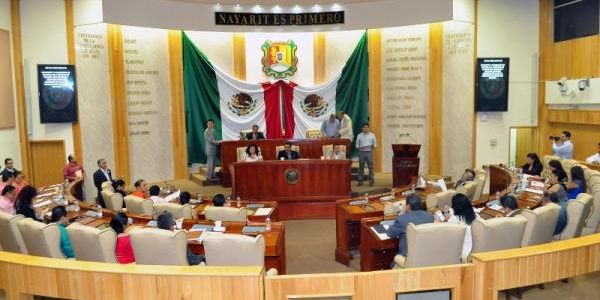

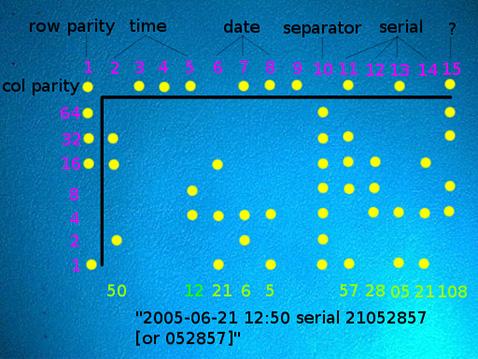







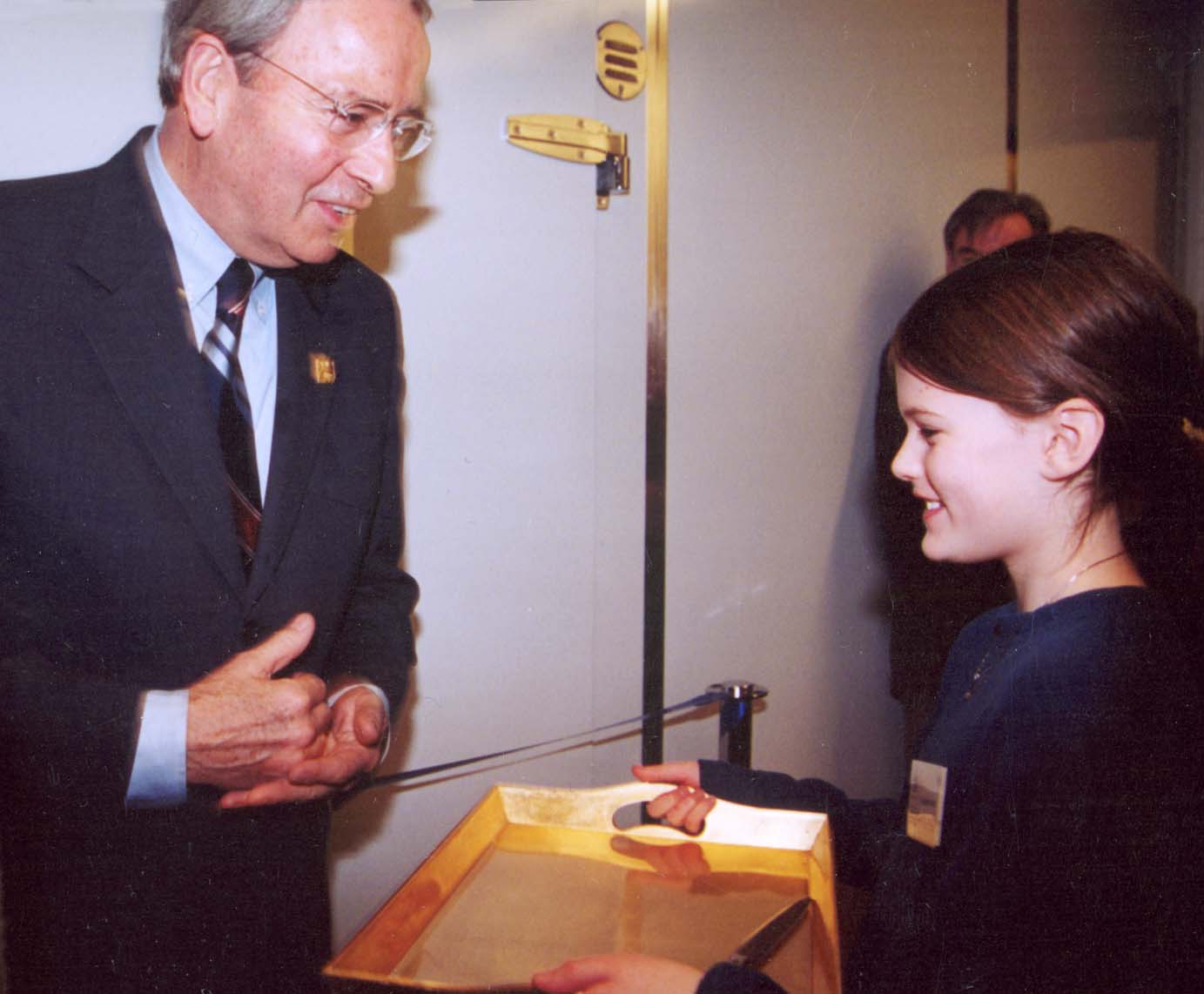
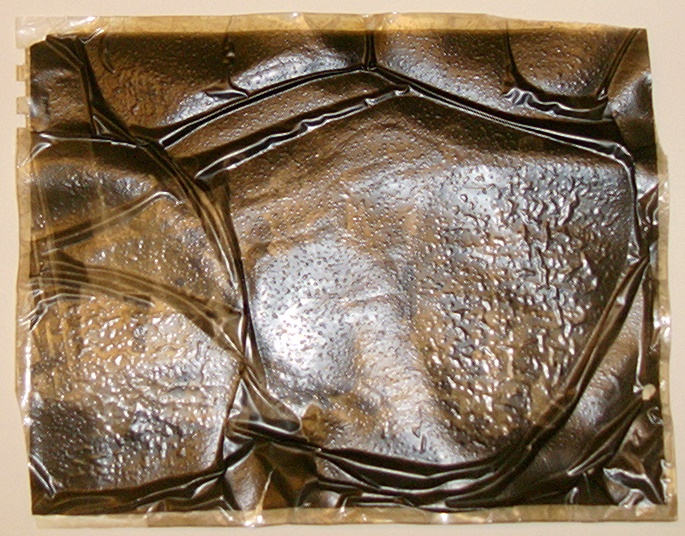
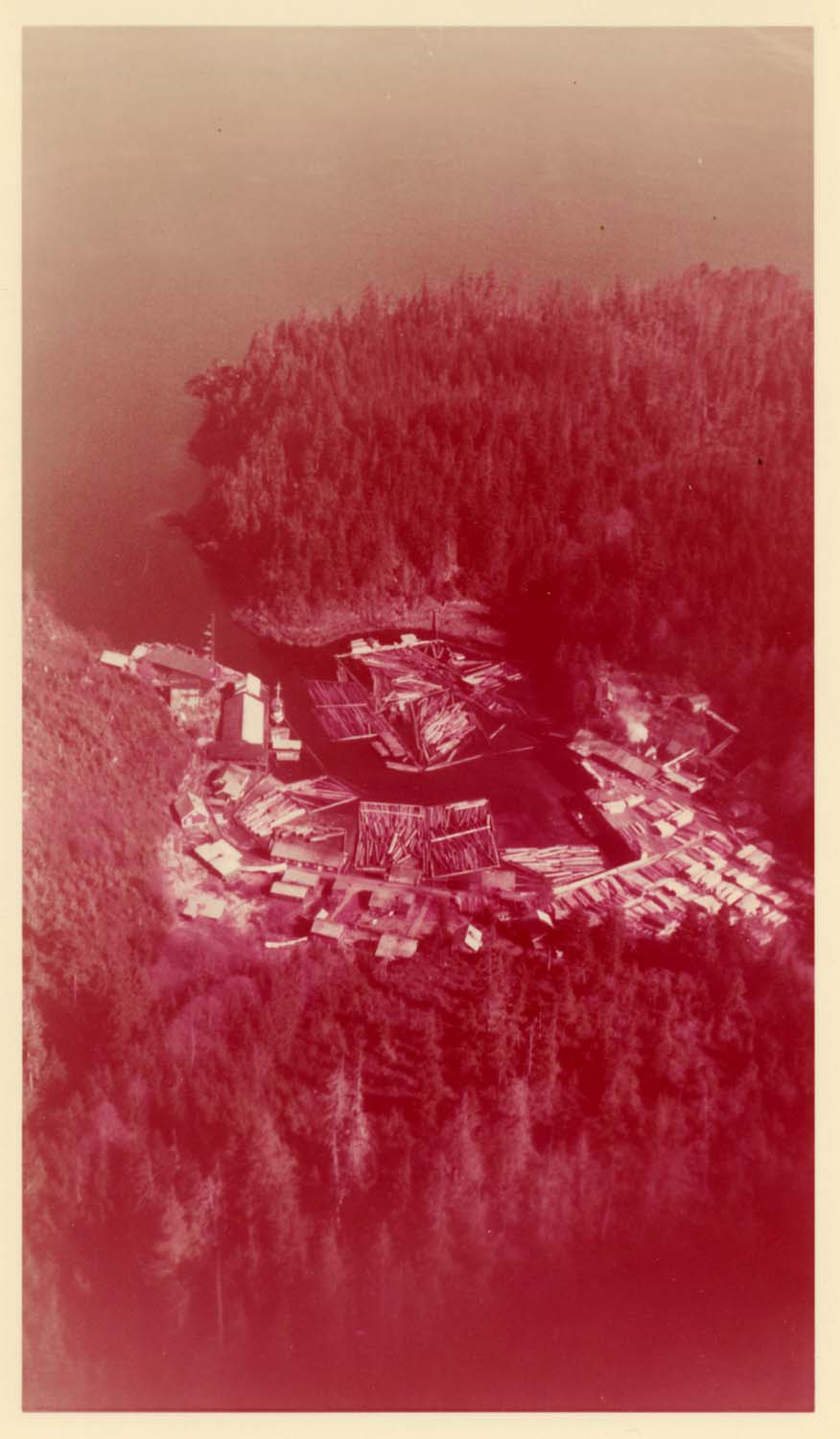
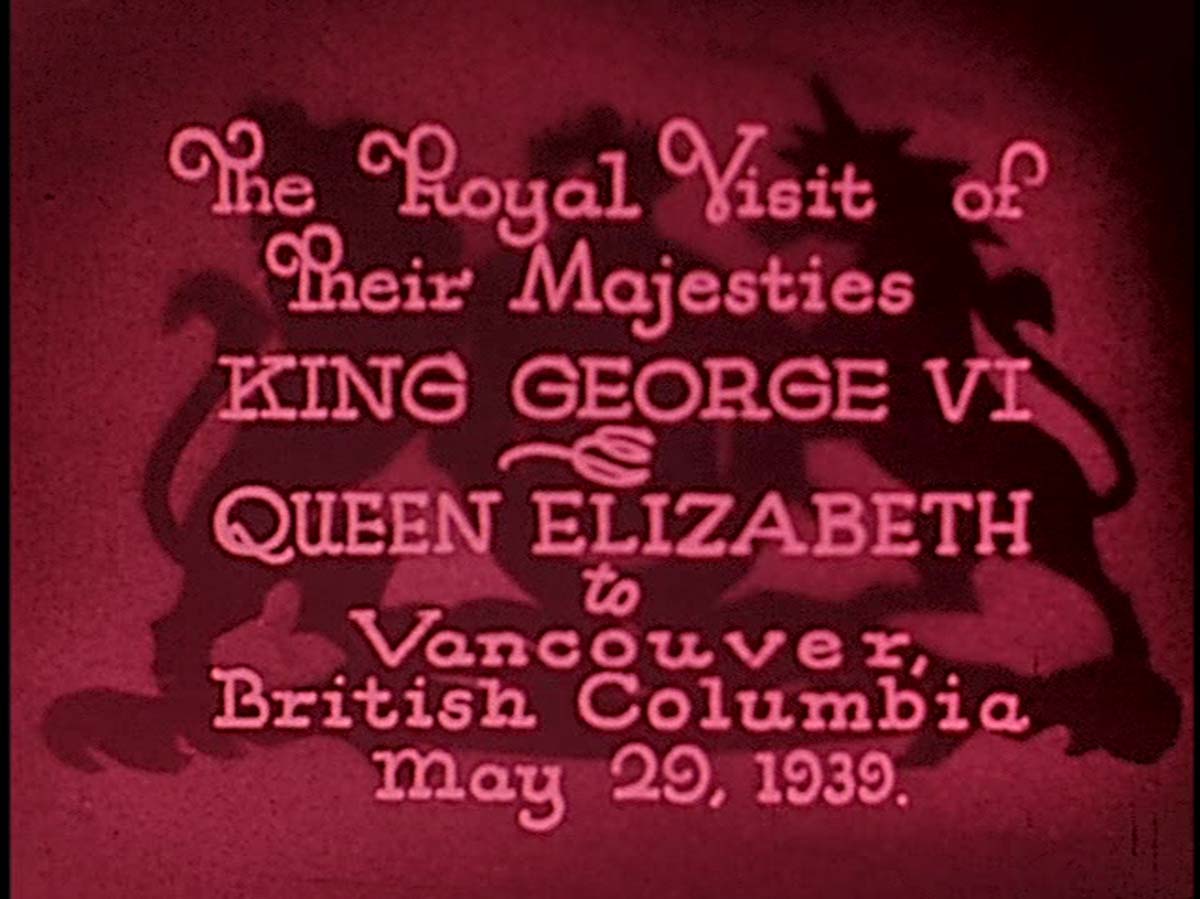
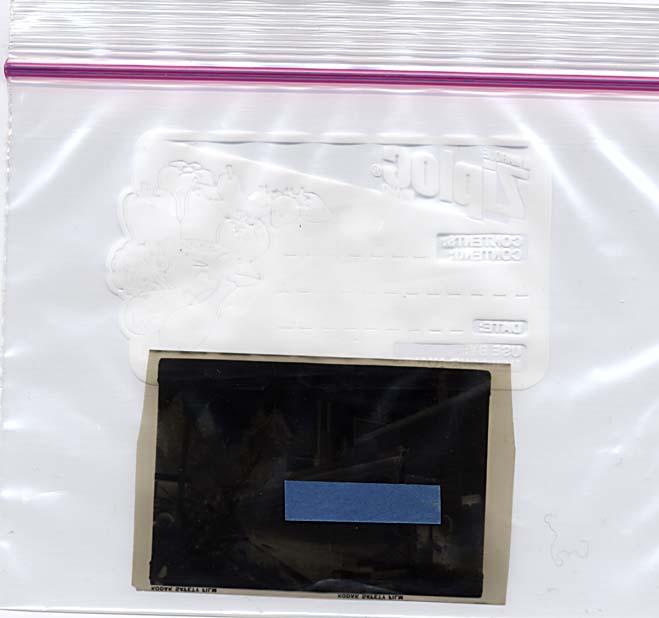
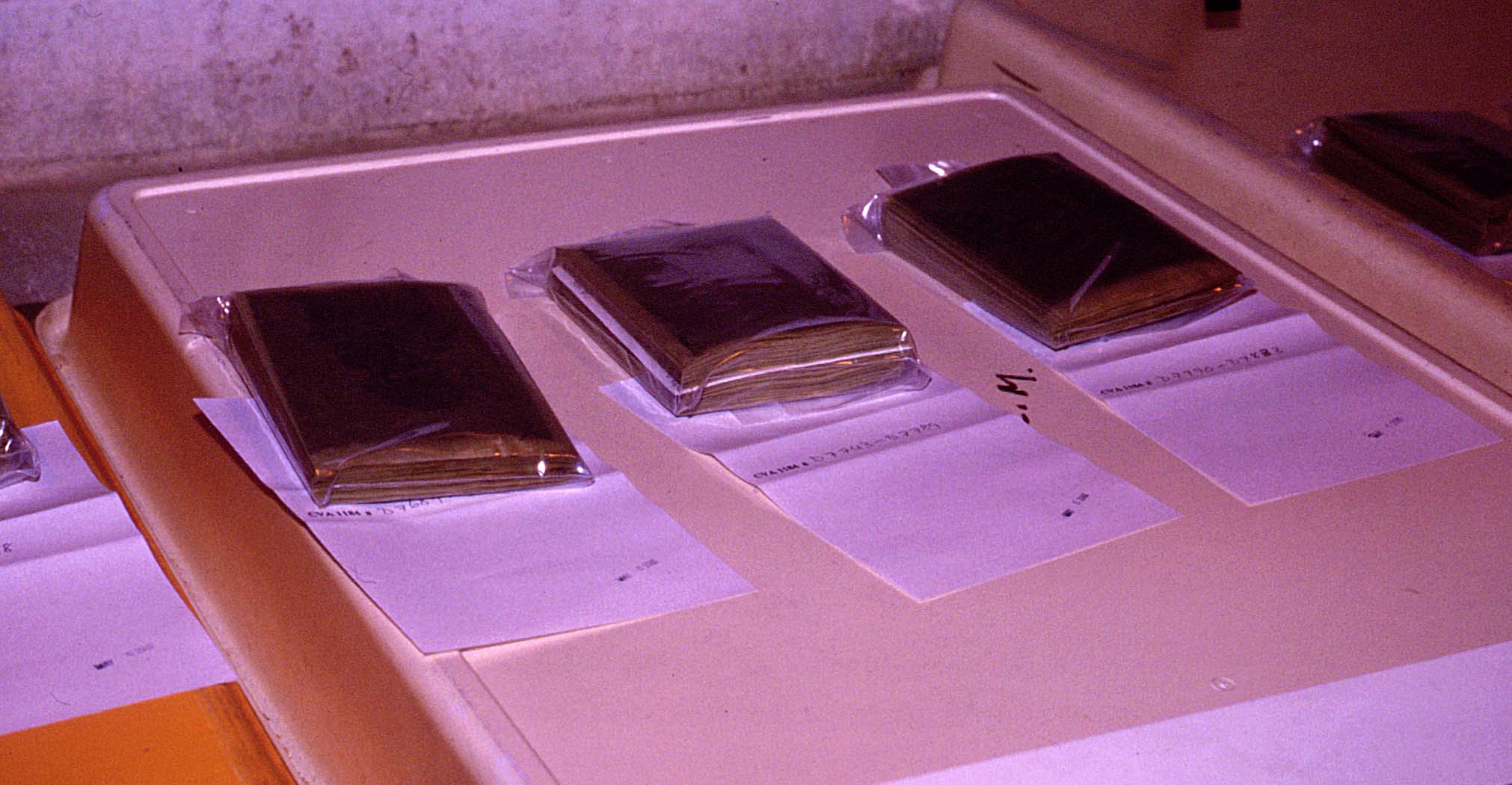
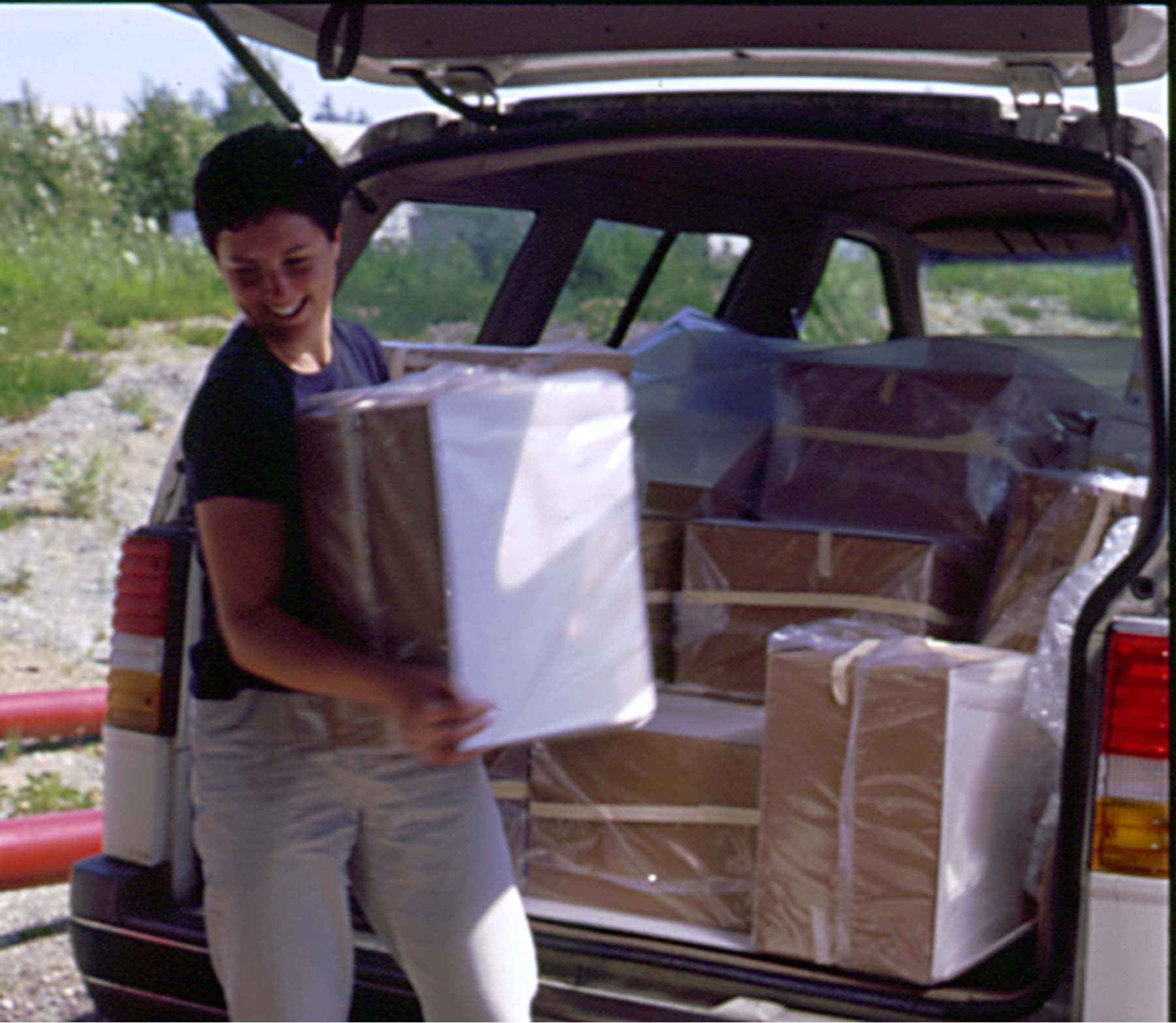
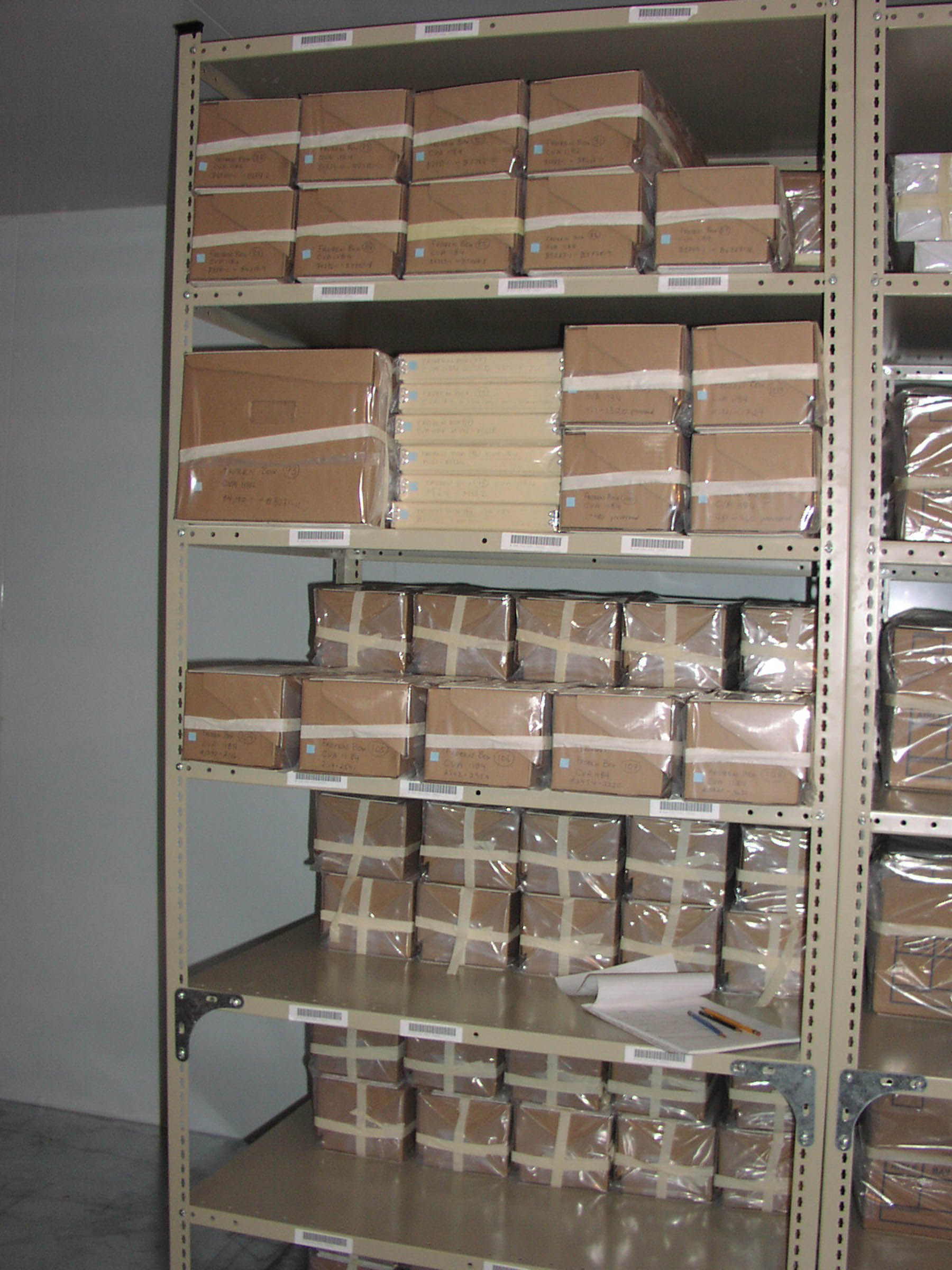
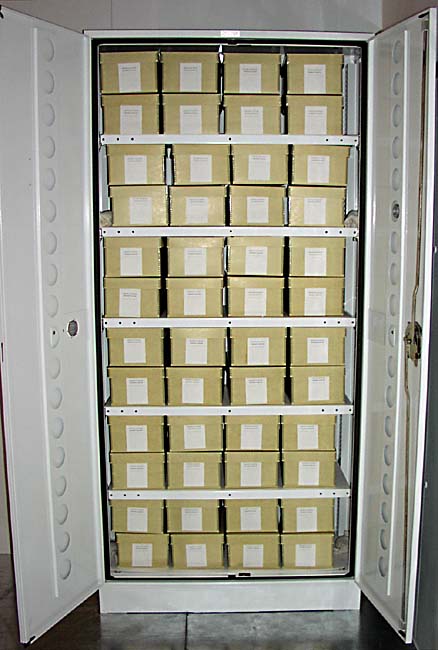


















![Cristobal Rojas [Public domain], via Wikimedia Commons. https://commons.wikimedia.org/wiki/File%3ACristobal_Rojas_37a.JPG Cristobal_Rojas_37a-viawikipedia](https://consecratedeminence.files.wordpress.com/2015/10/cristobal_rojas_37a-viawikipedia.jpg?w=500&h=403)






